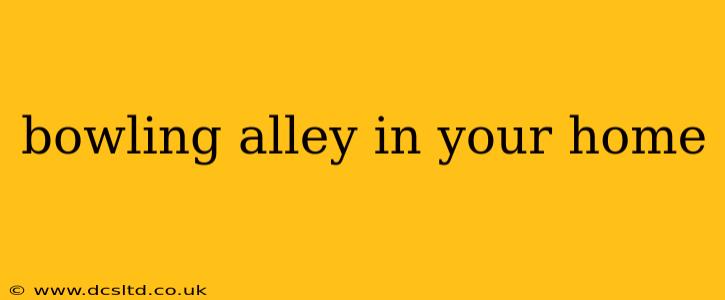The satisfying thud of a strike, the camaraderie of friendly competition – the allure of bowling is undeniable. But what if you could experience this thrill without ever leaving your home? Building a bowling alley in your house might sound like a fantastical undertaking, but with careful planning and execution, it's entirely achievable, albeit a significant investment. This comprehensive guide explores everything you need to know about transforming your basement or spare room into your very own private bowling paradise.
What Size Space Do I Need for a Home Bowling Alley?
This is the most crucial question. A standard bowling lane is 62 feet long, requiring a substantial amount of space. While shorter lanes exist, they compromise the true bowling experience. You’ll need to factor in not only the lane's length but also ample room for the approach, the back wall, seating, and potentially, a scoring system. A realistic minimum space would be approximately 70 feet long by 15 feet wide, but larger is always better for comfortable play and maneuvering. Consider your available space meticulously before embarking on this project.
How Much Does it Cost to Build a Home Bowling Alley?
The cost varies dramatically depending on the scale and ambition of your project. A basic, DIY approach focusing on a simplified lane could cost tens of thousands of dollars. However, a professionally installed, high-end alley with automated scoring, custom lighting, and premium materials could easily exceed $100,000 or more. Expect significant expenses in materials (wood, lane surfacing, pins, balls), labor (if you're not DIYing the entire project), and potential structural modifications to your home.
What Materials are Needed for a Home Bowling Alley?
Building a durable and functional bowling lane requires specific materials. The lane surface needs to be precisely engineered for ball roll and friction. Many professional alleys use synthetic materials designed for longevity and consistent performance. The approach area needs a non-slip surface, and the surrounding walls will require robust construction to withstand impact. Wood, typically maple, is often used for the lane itself due to its strength and durability, though composites are also available. You'll also need bowling pins, bowling balls, and a pinsetter (manual or automatic).
Can I Build a Mini Bowling Alley in My Home?
Yes, scaled-down versions are a more feasible option for those with limited space or budget. These mini-alleys, often found as children's playsets, are significantly shorter than standard lanes and use smaller balls and pins. They won't provide the exact same experience as a full-size alley, but they offer a fun alternative for smaller spaces.
What are the Legal and Safety Considerations?
Building any significant home addition requires permits and compliance with local building codes. Ensure you research and obtain all necessary permits before starting construction. Safety is paramount; ensure the lane surface is appropriately designed to prevent slips and falls, and the surrounding areas are well-lit and free from obstructions. Proper ventilation is also crucial, especially if you're working with certain materials.
Are there pre-fabricated bowling alley kits available?
While full, ready-to-assemble bowling alley kits are rare, you might find companies offering pre-fabricated components, such as lane sections or specialized flooring. Researching suppliers specializing in recreational facilities might uncover options for pre-made elements, reducing some of the DIY complexity. However, most projects will involve significant custom construction.
This guide provides a starting point for your home bowling alley dream. Remember to meticulously plan your project, budget realistically, and prioritize safety throughout the process. The end result – your own private bowling lane – is a uniquely rewarding achievement.
